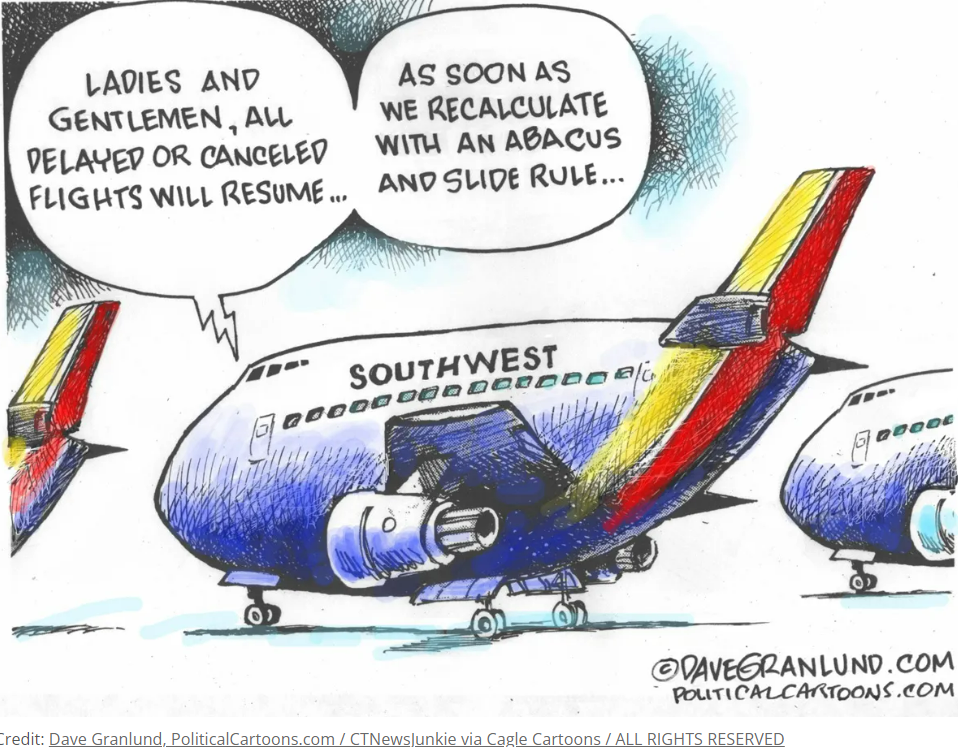Awhile back I wrote a post about 737 Max plane crashes and the management culture at Boeing that was responsible for them. Well, the Southwest Airline meltdown is looking like about the same story. Although right-wing media and David Sirota are blaming Pete Buttigieg, this is really another installment of how bean counters are destroying America.
A full analysis of why Southwest failed so spectacularly the past few days isn’t out yet, but after reading through a number of articles today it appears to come down to Southwest simply failing to invest in its own company. Instead it prioritized paying the largest possible dividends to stockholders. People within the industry are blaming Gary Kelly, who became Southwest CEO in 2004 and since 2008 has been the Chairman of the Board of Directors. He’s still chairman, although he stepped down as CEO in January 2022. Kelly’s background is strictly in accounting, with no hands-on experience in airline operations. Long-time Southwest employees today are saying that Kelly put other bean counters in charge of everything. The company for the past several years has been very good at squeezing out profits by cutting corners in technology, infrastructure and staffing. And it caught up to them these past few days, big time.
Michael Hiltzik at the Los Angeles Times writes,
“Our internal scheduling software can’t handle massive cancellations,” Michael Santoro, vice president of the Southwest pilots union, told my colleague Margot Roosevelt in an interview. “The company hasn’t invested the money into scheduling infrastructure to support the network they have developed.”
The outdated system is unequipped to handle rerouting involved in hundreds of cancellations, Santoro said. “So pilots are calling in asking, ‘I’m done with this flight — where do I go next? Am I running another plane? Do I spend the night here?’ And pilots are on hold for hours trying to figure out what to do next.”
When the weather is perfect, the software matches crews to planes. “But when there’s a disruption like this storm, our system can’t handle it,” Michael Massoni, first vice president of Transport Workers Union Local 556, which represents Southwest flight attendants, told Roosevelt.
“Southwest loses control because we don’t have 21st century technology. So what happens is chaos. Southwest starts to deal with the problem manually, which is incredibly tedious.”
The scheduling infrastructure, which some say hasn’t been updated in more than 20 years, seems to be the primary cause of the recent debacle, although not the only one.
Matt Stieb, New York magazine:
The main reason that their service collapsed and other companies held on was that Southwest runs what is called a “point-to-point” system, offering more direct flights to smaller destinations without returning to a home base between flights. After the pandemic and its huge shock to demand and labor in the aviation industry, many other airlines switched to the hub-and-spoke model: Airlines route the bulk of their traffic through major cities like Houston or Atlanta, then link out to smaller, final destinations. When demand is normal, the weather is good, and airlines are fully staffed, the point-to-point model is competitive because people love direct flights. But when a polar vortex hits the country on one of the biggest travel weeks of the year — amid ongoing staffing shortages — point-to-point becomes a huge mess.
While hub-and-spoke carriers were able to communicate easily with centrally located crews and cancel individual routes in order to control the damage from the storm, Southwest got snowed in. Crews were scattered at airports throughout its map of destinations; these teams use an antiquated phone system to get their flight assignments and could only wait so long for instructions without running into limits on how long they could go without a significant break — a problem that industry unions have been pointing out for years. “The catalyst was the big storm,” Michael Santoro, the vice-president of the Southwest Airlines Pilots Association, told the Los Angeles Times. “But our internal software can’t handle massive cancellations. The company hasn’t invested the money into scheduling infrastructure to support the network they have developed.”
For many Southwest flights, it was not the weather on Monday that caused the sweeping cancellations as much as the fact that the weather the previous week had dispersed its crews all across the country. Planes that may have been ready to go couldn’t find a full team, resulting in canceled flights; because the point-to-point system is dependent on previous flights getting in on time, the canceled flights multiplied until the system reached the brink of collapse.
The fact that other big airlines didn’t make this same mistake suggests this outcome was foreseeable.
It’s also rich that right-wing media (and David Sirota) blame Pete Buttigieg for not doing enough to prevent this disaster, since the Right is usually blaming government regulation for all the sins of the world. Lax oversight of the airline industry is arguably a bipartisan failure, since it has persisted too long to blame entirely on one party. But then came the Trump Administration, which basically told industrial America to “do whatever you want.” Enforcement fines against major U.S. airlines dropped by 88 percent between 2017 and 2019, it says here, an article published in 2019. So we’re looking at long-term systemic issues here and an FAA that has long has its hands tied. Maybe someday someone will make a persuasive argument that Pete Buttigieg could have done something to prevent the Southwest debacle, but I haven’t seen that argument yet.
You’ve probably also heard that Southwest has not been exactly generous in issuing refunds or giving stranded people meal and hotel vouchers. I expect Secretary Buttigieg to step up on this issue and make Southwest do right by its passengers. If he still has any presidential ambitions, this is his moment to be a hero.

